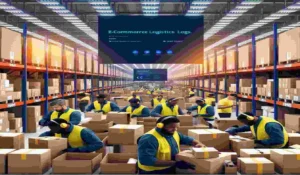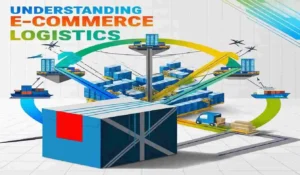Introduction to E-Commerce Logistics

In the fast-paced world of online retail, e-commerce logistics has become the backbone of successful businesses. But what exactly is e-commerce logistics, and why should you care? Well, imagine ordering your favorite gadget online and receiving a broken product weeks later. Frustrating, right? That’s where efficient ecommerce logistics comes into play.
Overview of e-commerce logistics
E-commerce logistics encompasses the entire journey of a product from the moment a customer clicks “buy” to when they unbox their purchase with glee. It’s like a well-choreographed dance involving inventory management, order fulfillment, shipping, and returns handling. Think of it as the behind-the-scenes magic that turns digital transactions into tangible customer satisfaction.
Importance of efficiency in e-commerce logistics
Now, why is efficiency so crucial in this dance? Picture this: You’re running an online store selling trendy sneakers. If your logistics aren’t up to snuff, you might end up with a warehouse full of last season’s styles, frustrated customers waiting weeks for their orders, or worse – lost packages. Efficient ecommerce logistics means happy customers, lower costs, and a healthier bottom line. It’s the secret sauce that separates the e-commerce winners from the also-rans.
Brief introduction to the six secrets
So, how do you master this intricate dance? That’s where our six secrets come in. These aren’t just any old tips – they’re the crown jewels of ecommerce logistics, distilled from years of industry experience and cutting-edge practices. From streamlining your order fulfillment to leveraging the power of data analytics, these secrets will transform your logistics from a clunky waltz to a smooth tango. Ready to boost your efficiency and leave your competition in the dust? Let’s dive in!
Understanding E-Commerce Logistics

Before we spill the beans on our six secrets, let’s get our heads around what e-commerce logistics really entails. It’s more than just shipping boxes – it’s an entire ecosystem that can make or break your online business.
Check out the article titled E-commerce Future USA: This informative piece sheds light on the bright future of e-commerce in the USA franchise market by 2024.
Definition and scope of e-commerce logistics
E-commerce logistics is the art and science of planning, implementing, and controlling the efficient flow of goods, services, and related information from the point of origin to the point of consumption. It’s like conducting a symphony orchestra – every element needs to work in harmony to create a beautiful customer experience.
The scope? It’s vast. We’re talking about everything from warehouse management and inventory control to order processing, packaging, shipping, and even handling returns. It’s the invisible force that turns a customer’s online wish into a real-world package on their doorstep.
Key components of e-commerce logistics
Let’s break it down into bite-sized pieces:
- Inventory Management: Knowing what you have, where it is, and when you need more.
- Order Fulfillment involves the process of selecting, packaging, and getting orders ready to be sent out.
- Warehousing: Storing products efficiently and safely.
- Transportation: Getting products from A to B (and sometimes back to A).
- Last-Mile Delivery: The final stretch of the journey to the customer’s hands.
- Reverse Logistics: Handling returns and exchanges smoothly.
Every part plays an essential role, working together smoothly like gears in a properly functioning engine. If one falters, the whole system can grind to a halt.
Challenges faced in e-commerce logistics

Now, let’s not sugarcoat it – e-commerce logistics is no walk in the park. It’s more like navigating a obstacle course blindfolded. Here are some hurdles you might encounter:
- Inventory Forecasting: Crystal balls not included. Predicting demand is tough, especially with seasonal fluctuations.
- Cost Management: Balancing speed and affordability is like walking a tightrope.
- Customer Expectations: In the age of same-day delivery, patience is a rare commodity.
- Technology Integration: Keeping up with the latest tech can feel like chasing a moving target.
- Global Complexities: International shipping? Hello, customs headaches and regulatory mazes.
But don’t worry – our six secrets will help you tackle these challenges head-on. Ready to unlock the first one?
Secret 1: Streamline Order Fulfillment

Alright, let’s kick things off with the first secret weapon in your e-commerce logistics arsenal: streamlining your order fulfillment. This is where the rubber meets the road in your operations.
Importance of a seamless order fulfillment process
Picture this: You’re a customer who’s just splurged on a limited edition collectible figurine. You’re excited, counting down the days until it arrives. But instead of a swift delivery, you’re met with delays, incorrect items, or worse – a damaged product. Ouch! That’s the opposite of a seamless order fulfillment process.
Tips for optimizing order processing times
Ready to supercharge your order processing? Here are some pro tips:
- Organize your warehouse layout: Think of it as a game of Tetris. Arrange popular items for easy access, and group related products together.
- Implement batch picking: Instead of picking items for one order at a time, group similar orders and pick for them simultaneously. It’s like catching the two (or many) birds in one shot.
- Use barcode scanners: Ditch the manual data entry. Barcode scanners are faster and more accurate – it’s like upgrading from a bicycle to a sports car.
- Prioritize orders: Not all orders are created equal. Set up a system to flag urgent or VIP orders for special handling.
- Regular training for staff: Your team is your greatest asset. Regular training keeps them sharp and efficient.
Implementing technology to automate fulfillment tasks
Welcome to the future of order fulfillment! Automation is no longer a luxury, it’s an absolute necessity to remain in the game. Here’s how you can leverage technology:
- Warehouse Management Systems (WMS): These are like the brain of your operations, coordinating all aspects of your warehouse activities.
- Robotic Process Automation (RPA): Use bots to handle repetitive tasks like data entry or inventory updates. It’s like having tireless digital assistants.
- Conveyor systems and sorting machines: These can significantly speed up the picking and packing process. Think of it as a rollercoaster for your products!
- Automated packaging machines: These can select the right box size, pack items, and even print shipping labels. It’s packaging on autopilot!
Remember, the goal is to reduce human error, speed up processes, and free up your team to focus on tasks that require a human touch. With these strategies in place, you’ll be well on your way to order fulfillment nirvana!
Secret 2: Optimize Inventory Management

Let’s move on to our second secret: mastering the art of inventory management. This is where you’ll separate yourself from the amateurs and join the big leagues of e-commerce logistics.
The role of inventory management in logistics efficiency
Think of inventory management as the heartbeat of your e-commerce operation. Get it right, and everything flows smoothly. Get it wrong, and you’re looking at a logistical nightmare.
A well-organized inventory management system will ensure you have the right items in the right quantity at the appropriate moment. It’s like being a master juggler, keeping all your products in the air without dropping a single one. This balance is crucial for meeting customer demand, minimizing storage costs, and preventing the dreaded “out of stock” message that sends customers running to your competitors.
Strategies for accurate inventory tracking
Accurate inventory tracking is like having a crystal ball for your business. Here are some strategies to sharpen your foresight:
- Implement a robust Inventory Management System (IMS): This is your command center. A good IMS gives you real-time visibility into your stock levels, sales trends, and reorder points.
- Use RFID technology: Radio Frequency Identification tags are like GPS for your products. They provide real-time tracking and can significantly reduce human error.
- Conduct regular cycle counts: Don’t wait for your annual stocktake. Regular cycle counts (partial inventory checks) help you stay on top of discrepancies.
- Adopt the ABC analysis: Not all products are created equal. Categorize your inventory into A (high value, low quantity), B (moderate value and quantity), and C (low value, high quantity) items. This helps you prioritize your management efforts.
- Implement a First-In-First-Out (FIFO) system: This is especially crucial for perishable goods. The first items to enter your inventory should be the first to leave.
Balancing inventory levels to meet demand
Balancing inventory is like walking a tightrope. Lean too far one way, and you’re drowning in excess stock. Lean too far the other, and you’re constantly out of stock. Here’s how to find your balance:
- Use demand forecasting tools: These use historical data and market trends to predict future demand. It’s similar to having a weather forecast in your business.
- Implement safety stock: This is your buffer against unexpected spikes in demand or supply chain disruptions. Think of it as your rainy-day fund.
- Consider dropshipping for certain products: This can help you offer a wider range of products without the inventory risk. It’s like having your cake and eating it too!
- Utilize Just-In-Time (JIT) inventory: This approach minimizes inventory holding costs by receiving goods only as they’re needed. It’s a delicate choreography, but when done properly it’s gorgeous.
- Monitor slow-moving inventory: Keep an eye on products that aren’t selling. Consider promotions or bundling to move these items before they become dead stock.
By mastering these strategies, you’ll be well on your way to inventory management excellence. Remember, in the world of e-commerce logistics, a well-managed inventory is worth its weight in gold!
Secret 3: Enhance Supply Chain Collaboration

Now, let’s uncover our third secret: the power of collaboration in your supply chain. In the interconnected world of e-commerce, no business is an island. Your success depends on how well you play with others.
Building strong relationships with suppliers and partners
Imagine your supply chain as a relay race. Each participant – from suppliers to logistics partners – needs to perform flawlessly and hand off the baton smoothly. Here’s how to build a winning team:
- Open communication: Foster an environment where information flows freely. Regular check-ins and updates can prevent minor hiccups from becoming major disasters.
- Shared goals: Align your objectives with those of your partners. When everyone’s rowing in the same direction, you’ll reach your destination faster.
- Long-term partnerships: Don’t treat suppliers as disposable. Building long-term relationships can lead to better terms, priority service, and mutual growth.
- Performance metrics: Establish clear KPIs for your partners. It’s like having a shared scoreboard – everyone knows what success looks like.
- Mutual benefit: Look for win-win solutions. If your partners succeed, you succeed. It’s not a zero-sum game!
Leveraging technology for better communication
In today’s digital age, technology is the glue that holds your supply chain together. Here’s how to leverage it:
- Supply Chain Management (SCM) software: This is your command center, giving you visibility across your entire supply chain. It’s like having x-ray vision for your operations.
- Electronic Data Interchange (EDI): EDI allows for seamless, automated communication between you and your partners. It’s faster, more accurate, and reduces paperwork. Think of it as a universal translator for your supply chain.
- Cloud-based collaboration tools: Platforms like Slack or Microsoft Teams can facilitate real-time communication and document sharing. It’s like having a virtual war room for your team.
- Blockchain technology: While still emerging, blockchain can provide unparalleled transparency and traceability in your supply chain. It’s like having an incorruptible ledger for all transactions.
The Impact of Logistics Partners on Supply Chain Optimization
In the intricate web of supply chain optimization, an ecommerce logistics partner plays a pivotal role. They streamline operations and increase delivery efficiency. A strategically located distribution center ensures swift processing and dispatch, drastically reducing delivery times. For any ecommerce business, this collaboration is crucial, fostering agility and scalability while meeting customer expectations with precision and speed.
Secret 4: Leverage Data Analytics

In today’s highly competitive marketplace entrepreneurs must make use of the power of data analytics in order to change the way they approach their logistics solutions . Through the use of insights gained from analytics, an online retailer can improve its fulfillment processes and enhance every part of its logistics procedure. As business expands and expands, data analytics can assist in deciding on the best shipping provider and making educated choices about the storage and distribution of the inventory. This approach to business allows them to anticipate changes in demand and reduce operating costs and improve customer satisfaction, putting them at the top of their field.
Read this article: Lean E-Commerce in 3 Steps: Simplify, Save, Succeed
The Power of Data in E-Commerce Logistics
Data is the currency of modern logistics. By harnessing the power of data analytics, businesses can gain valuable insights into customer behavior, demand patterns, and operational inefficiencies.
Using Analytics to Forecast Demand and Manage Resources
- Demand Forecasting: Use historical data to predict future demand and optimize inventory levels.
- Resource Allocation: Allocate resources like labor and equipment based on data-driven insights.
- Performance Tracking: Monitor key performance indicators (KPIs) to identify areas for improvement.
Tools and Technologies for Effective Data Analysis
Advanced analytics tools like predictive analytics, machine learning, and artificial intelligence can transform raw data into actionable insights. By investing in these technologies, businesses can make informed decisions and enhance their logistics efficiency.
Secret 5: Implement Flexible Shipping Solutions

In the fast-paced business of ecommerce logistics the need to implement flexible shipping solutions is essential to be successful. If you are operating a B2B business or an online marketplace or store it is essential that every order gets to the correct location in the correct time. Working with 3PLs 3PL could bring significant benefits because the logistics provider is able to adjust to changing demands. This flexibility in logistics entails improving routes, cutting expenses, and enhancing satisfaction of customers. As companies send out orders by using flexible solutions, they will make them a leader of their field, making sure that the delivery of each parcel is quickly.
Understanding Different Shipping Options and Their Benefits
Shipping isn’t a one-size-fits-all. Offering a assortment of shipping options including standard, expedited and same-day delivery allows clients to pick which option is best for them. This flexibility improves satisfaction of customers and could help your business gain an advantage.
What is HTML0? negotiate lower rates for Carriers
Negotiation is a craft. By building solid relationships with carriers by consolidating your shipments and maximizing your shipping volumes, you can get better rates, thus cutting shipping costs, and increasing your profits.
Adapting to Customer Preferences for Faster Delivery
The expectations of customers are changing and speedy deliveries are no longer an option but essential. To meet these requirements, you should consider strategies like distributed warehousing which places the inventory closer to the customers, thus reducing the time to deliver.
Secret 6: Focus on Customer Experience

The importance of focusing on the customer experience is essential for companies that want to succeed in the current competitive marketplace. When goods are transported across the nation and the process affects the customer’s satisfaction. Ecommerce platforms that emphasize seamless interaction can make companies stand from the crowd. From managing the inventory at the factory until the delivery date every touchpoint is crucial. The efficient processes used in storage and shipping will ensure that products arrive quickly and in good in perfect condition. Through creating memorable experiences, companies build trust and loyalty, turning new customers into regular ones who turn into brand ambassadors.
The Link Between Logistics and Customer Satisfaction
Logistics are the invisibly thread that connects businesses with the customers they serve. Efficient logistics operations ensure prompt delivery as well as accurate order fulfillment and easy returns that make for a pleasant satisfaction of the customer.
Providing Real-Time Tracking and Updates
In an age where consumers need information on the go offering real-time tracking and updates is crucial. Implementing tracking technology will not only keep customers updated but also decreases queries and improves transparency.
Strategies for Handling Returns Efficiently
Returns are an essential aspect of e-commerce, however they shouldn’t cause a hassle. Streamline the returns process by establishing clear policies with easy return labels and fast refunds to keep the trust of customers and ensure their satisfaction.
Integrating Technology in E-Commerce Logistics
Overview of Essential Technologies in Logistics
technology is at the foundation in modern-day logistics. From warehouse management systems (WMS) to transportation management systems (TMS) These tools improve processes, decrease the chance of errors and boost efficiency.
Enhancing Efficiency through AI and Machine Learning Techniques
Machine learning and AI are game changers in the field of logistics. They can anticipate demand, optimize routes and even process customer service calls which frees the human resources to perform more important tasks.
The Role of IoT in Real-Time Tracking and Monitoring
HTML0 is the Internet of Things (IoT) connects physical devices, which allows real-time monitoring and tracking of deliveries. IoT devices provide information about location temperatures, temperature, and conditions and ensure that the items are delivered safely and effectively.
Sustainability in E-Commerce Logistics

Importance of Sustainable Practices in Logistics
Sustainable isn’t a buzzword, it’s an absolute requirement. Implementing eco-friendly practices doesn’t just benefit the environment, but is also appealing to eco-conscious customers.
Strategies for Reducing the Carbon Footprint
- Optimize routes Make use of the software for optimization of routes to decrease the amount of fuel consumed.
- Eco-friendly Packaging Switch to recyclable and biodegradable material for packaging.
- Green Warehousing Use energy efficient practices within warehouses.
Benefits of Eco-Friendly Packaging and Shipping
Sustainable packaging does not just reduce waste but also improves your brand’s reputation. Consumers are more and more attracted to companies that are environmentally responsible.
What do you make outsourcing logistics operations more efficient? the growth of e-commerce?
The Benefits of Outsourcing E-Commerce Warehousing Services
Outsourcing warehousing may let resources and experience go to waste which allows businesses to concentrate on their core competences. Third-party logistics suppliers (3PLs) provide specialized services that boost the efficiency and capacity of.
Maximizing Efficiency Through Outsourced Last-Mile Delivery Solutions
Last-mile delivery can be the most expensive and difficult aspect in logistics. Partnering with 3PLs for last-mile delivery could enhance speed, decrease costs, and increase customer satisfaction.
What’s the e-commerce challenges logistics? And how can we overcome them?
Managing Rising Shipping Costs in E-Commerce Business
The rising cost of shipping could reduce profits, however through strategic planning, businesses can reduce these costs. Explore options like carrier negotiation, and combining the shipping of shipments to cut expenses.
Optimizing Logistics Processes to Handle Peak Order Seasons
Peak seasons can strain the logistics process. By forecasting demand, boosting personnel, and improving processes, companies can manage surges without sacrificing effectiveness.
Enhancing Warehouse Management Systems for Scalability
Scalability is essential to expansion. Implementing advanced warehouse management systems (WMS) can increase efficiency of processes, improve accuracy of inventory and allow for business expansion.
Measuring Success in E-Commerce Logistics

Key Performance Indicators (KPIs) for Logistics Efficiency
KPIs are crucial to gauge the performance of logistics. Metrics like accuracy of orders, timely delivery and return rates can provide insight into areas for improvement.
How to Set Benchmarks and Measure Progress
Comparing benchmarks to industry norms as well as competitors can help identify gaps in performance. Regularly reviewing KPIs and setting achievable goals will ensure continuous improvement.
Tools for Tracking Logistics Performance
The performance of logistics can be monitored with various tools, such as dashboards, reports as well as analytics platform. These tools offer real-time information and support the use of data to make decisions.
Future Trends in ECommerce Logistics
Emerging Trends Shaping the Future of Logistics
The logistics landscape is continually evolving. Emerging trends such as drone deliveries, self-driving vehicles and blockchain are set to transform the logistics industry.
How Technology Is Transforming Logistics Practices
technology is an engine for innovation in the logistics industry. Automation, AI and IoT have been boosting efficiency while reducing costs and improving customer service.
Preparing Your Business for Future Logistics Demands
Being ahead in logistics demands adaptability. Investing in technology, fostering innovation and adapting to change are vital to be able to meet future demands.
Conclusion
In the world of e-commerce, efficient logistics can make or break a business. By implementing these six secrets–streamlining order fulfillment, optimizing inventory management, enhancing supply chain collaboration, leveraging data analytics, implementing flexible shipping solutions, and focusing on customer experience–businesses can boost efficiency and deliver exceptional value to customers. Succeeding in this ever-changing field requires constantly getting better and being able to adjust quickly. So, embrace these strategies and set your e-commerce business on the path to logistics success.
FAQs
How do I improve your order fulfilment process efficiently?
Automate orders by centralizing fulfillment centres, using batch processing, and utilizing barcode technology to minimize mistakes.
What impact does data analytics have in the logistics of e-commerce?
Data analytics help predict demand, improve the allocation of resources, and track the performance of resources, which results in better efficiency and better decision-making.
How can I decrease my carbon footprint from logistical processes?
Lower your carbon footprint by maximizing routes, utilizing eco-friendly packaging and adopting green techniques in your warehouses.
What are the reasons to think about outsourcing logistics?
The outsourcing of logistics could improve effectiveness, capacity and experience which allows you to concentrate on the core business functions.
What are the next trends in logistics for e-commerce?
The future of technology includes drones, self-driving vehicles and blockchain. These are expected to transform logistics processes and improve efficiency.
